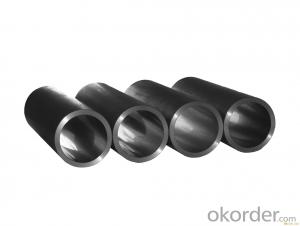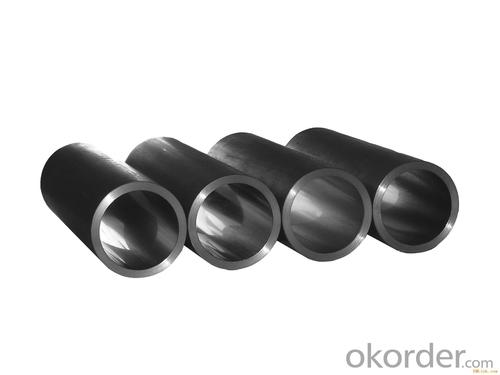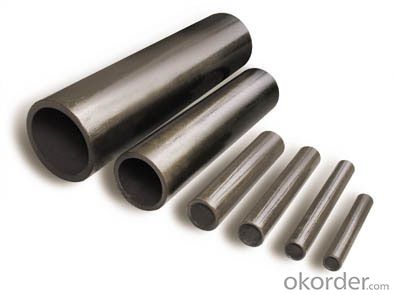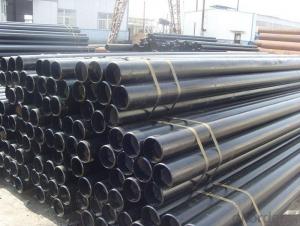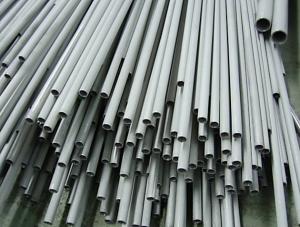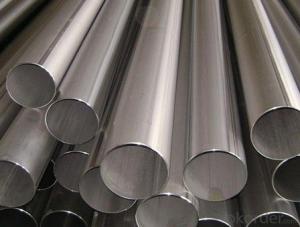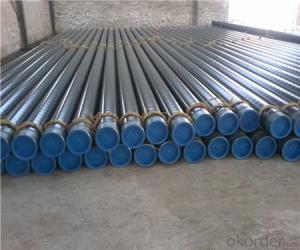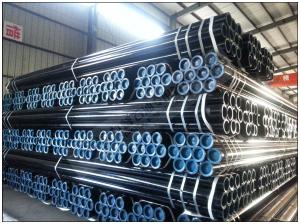GB DIN ASTM ASME API 5L Seamless Steel Tube
- Loading Port:
- Tianjin
- Payment Terms:
- TT or LC
- Min Order Qty:
- 25 m.t.
- Supply Capability:
- 10000 m.t./month
OKorder Service Pledge
OKorder Financial Service
You Might Also Like
We are company that have many years experience and professional manager team and engineer team and sales team, sure we will provide you high quality of pipe and professioanl service.
Seamless pipe possesses a hollow section and without seam around the strip steel. It is made with solid bar or steel ingot by perforating machine. As the facture process does not include any welding, seamless pipes are considered to be stronger and more durable. Generally speaking, seamless pipe has better pressure resistance and security than other classifications, and was usually more easily available than welded pipe.
2、Main Features of the Seamless Pipe:
• High working accuracy
• High strength
• Small inertia resistance
• Strong therming dissipine ability
• Good appearance
• Reasonble price
3、Seamless Pipe Specification:
Standard | GB, DIN, ASTM ASTM A106-2006, ASTM A53-2007 |
Grade | 10#-45#, 16Mn 10#, 20#, 45#, 16Mn |
Thickness | 8 - 33 mm |
Section Shape | Round |
Outer Diameter | 133 - 219 mm |
Place of Origin | Shandong, China (Mainland) |
Secondary Or Not | Non-secondary |
Application | Hydraulic Pipe |
Technique | Cold Drawn |
Certification | API |
Surface Treatment | factory state or painted black |
Special Pipe | API Pipe |
Alloy Or Not | Non-alloy |
Length | 5-12M |
Outer Diameter | 21.3-610mm |
Grade | 20#, 45#, Q345, API J55, API K55, API L80, API N80, API P110, A53B |
Standard | ASME, ASTM |
1) Material:20#(ASTM A 106/A53 GRB.API5LGRB,GB),45#,16Mn,10#.
2) Specification range: OD: 21.3-610mm, WT:6-70mm, length:6-12m or according to the requirement of clients.
3) Executive standards: GB, ASME API5L.ASTM A 106/A53,Despite of the above standards, we can also supply seamless steel pipe with standard of DIN, JIS, and so on, and also develop new products according to the requirements of our clients!
4) Surface: black lacquered, varnish coating or galvanized.
5) Ends: Beveled or square cut, plastic capped, painted.
6) Packing: bundles wrapped with strong steel strip, seaworthy packing.
4、Packaging & Delivery:
Packaging Details: | seaworthy package, bundles wrapped with strong steel strip |
Delivery Detail: | 15-30days after received 30%TT |
5、FAQ of Seamless Pipe:
①How is the quality of your products?
We have many years business experience in this area, and we have professional engineer and manager team and sure we can provide you high quality production and professional service.
②How about price?
Yes, we are factory and be able to give you lowest price below market one, and we have a policy that “ for saving time and absolutely honest business attitude, we quote as lowest as possible for any customer, and discount can be given according to quantity”,if you like bargain and factory price is not low enough as you think, just don’t waste your time.Please trust the quotation we would give you, it is professional one.
③Why should you chose us?
We can give you both.Additionally, we can also offer professional products inquiry, products knowledge train(for agents), smooth goods delivery, exellent customer solution proposals.Our service formula: good quality+good price+good service=customer’s trust
SGS test is available, customer inspection before shipping is welcome, third party inspection is no problem.
6、Seamless Pipe Images:
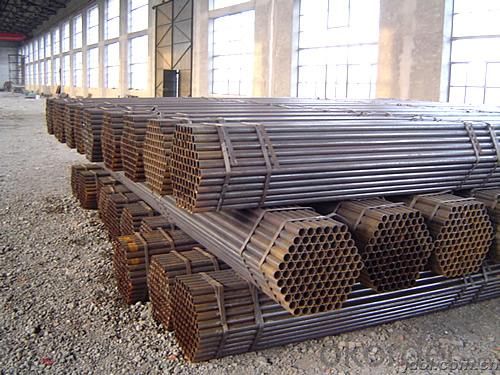
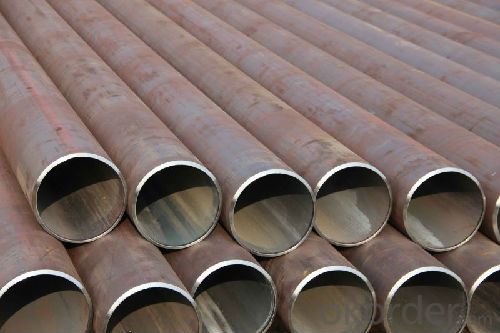
- Q: What are the different sizes of steel pipe nipples?
- The sizes of steel pipe nipples vary depending on their intended use and application. Common sizes include 1/8", 1/4", 3/8", 1/2", 3/4", 1", 1 1/4", 1 1/2", and 2". However, there are many other sizes available to cater to specific needs and requirements.
- Q: What are the different methods of repairing steel pipes?
- There are several methods of repairing steel pipes including welding, pipe wrapping, epoxy lining, and pipe bursting. Welding involves joining the broken sections of the pipe using heat and a filler material. Pipe wrapping involves applying a layer of epoxy or fiberglass wrap around the damaged area to reinforce and seal it. Epoxy lining involves applying a coating of epoxy resin on the interior of the pipe to prevent corrosion and restore structural integrity. Pipe bursting is a more invasive method where a new pipe is pulled through the existing damaged pipe, breaking it apart and replacing it in the process.
- Q: Can steel pipes be used for HVAC systems?
- Yes, steel pipes can be used for HVAC systems. Steel pipes are commonly used in HVAC systems for their durability, strength, and resistance to corrosion. They are suitable for transporting hot or cold air, water, or refrigerant throughout the system.
- Q: What is hot rolled steel pipe? What is a cold drawn steel tube?
- Overview of two processesHot-rolled (extrusion seamless pipe): billet, heating, perforation, three roll cross rolling, rolling or extrusion, tube to tube diameter (or reducing) - cooling - tube, straightening, pressure test (or testing), marking and warehousing.Cold drawing (rolling) seamless steel pipe: round tube to heating to perforation, annealing, pickling, leading to oil (copper), multi pass drawing (Leng Zha), the blank pipe, heat treatment, straightening, pressure test (testing), marking and warehousing.
- Q: What is the single length of galvanized steel pipe?
- Galvanized steel pipe is divided into cold galvanized steel pipe, hot galvanized steel pipe, cold galvanized steel pipe has been banned, and the latter is also advocated by the state for the moment, can be used. In 60s and 70s, developed countries began to develop new types of pipes, and galvanized pipes were banned.
- Q: Can steel pipes be used for transporting liquids and gases?
- Yes, steel pipes can be used for transporting liquids and gases. Steel pipes are commonly used in various industries, such as oil and gas, water supply, and chemical processing, due to their durability, strength, and resistance to corrosion. They are capable of safely and efficiently transporting a wide range of liquids and gases over long distances.
- Q: How are steel pipes used in the textile industry?
- Steel pipes are used in the textile industry to create a network of pipes for transporting water, steam, and other fluids that are crucial for various processes such as dyeing, washing, and finishing fabrics. These pipes ensure the efficient and reliable supply of these fluids, contributing to the smooth functioning of textile manufacturing operations.
- Q: What are the common defects found in steel pipes?
- Some common defects found in steel pipes include corrosion, cracks, dents, and leaks. Other defects may include misalignment or misshapen sections, improper welding, and brittleness.
- Q: Can steel pipes be used for underground chemical injection?
- Underground chemical injection can utilize steel pipes. These pipes are widely employed across industries due to their durability, strength, and resistance to corrosion. For underground chemical injection purposes, steel pipes bring various advantages. They can endure high pressure and temperature, making them suitable for the transportation and injection of chemicals into the ground. Furthermore, steel pipes exhibit superb chemical resistance, guaranteeing that they will not interact with the injected chemicals and compromise the system's integrity. Nevertheless, it is crucial to select the appropriate grade of steel pipe that is compatible with the specific chemicals being injected to ensure optimal performance and longevity. Regular maintenance and inspections are also necessary to identify any potential corrosion or damage to the pipes, thus ensuring the safe and efficient operation of the chemical injection system.
- Q: What is the difference between steel pipe and PVC conduit?
- Steel pipe and PVC conduit are both used for different purposes and have different characteristics. One of the main differences between steel pipe and PVC conduit is their material composition. Steel pipe is made of a sturdy and durable material, typically carbon steel or stainless steel. This makes it strong and resistant to impact, making it suitable for heavy-duty applications such as plumbing or structural support. On the other hand, PVC conduit is made of polyvinyl chloride, a type of plastic. PVC is lightweight, flexible, and easy to work with, making it ideal for electrical applications such as protecting and routing electrical wires. Another difference is their resistance to corrosion. Steel pipe is more resistant to corrosion than PVC conduit, especially when coated with protective layers such as zinc or epoxy. This makes steel pipe suitable for outdoor applications, underground installations, or environments with high moisture or corrosive elements. PVC conduit, while generally resistant to moisture and chemicals, may deteriorate over time when exposed to sunlight and can be damaged by certain chemicals. Cost is another factor to consider. Steel pipe is generally more expensive than PVC conduit due to its material and manufacturing process. However, steel pipe's durability and long lifespan make it a cost-effective choice in the long run, especially for applications that require high strength and longevity. PVC conduit, on the other hand, is relatively inexpensive and readily available, making it a more affordable option for many electrical projects. Lastly, installation methods differ between the two. Steel pipe is typically joined together using threaded connections or welded joints, requiring specialized tools and skills. PVC conduit, on the other hand, can be easily cut, assembled, and connected using PVC cement or fittings. This makes PVC conduit a more DIY-friendly option for electrical installations. In summary, the main differences between steel pipe and PVC conduit lie in their material composition, resistance to corrosion, cost, and installation methods. Steel pipe is strong, durable, and corrosion-resistant, making it suitable for heavy-duty applications. PVC conduit, on the other hand, is lightweight, flexible, and affordable, making it ideal for electrical projects.
Send your message to us
GB DIN ASTM ASME API 5L Seamless Steel Tube
- Loading Port:
- Tianjin
- Payment Terms:
- TT or LC
- Min Order Qty:
- 25 m.t.
- Supply Capability:
- 10000 m.t./month
OKorder Service Pledge
OKorder Financial Service
Similar products
Hot products
Hot Searches
Related keywords
